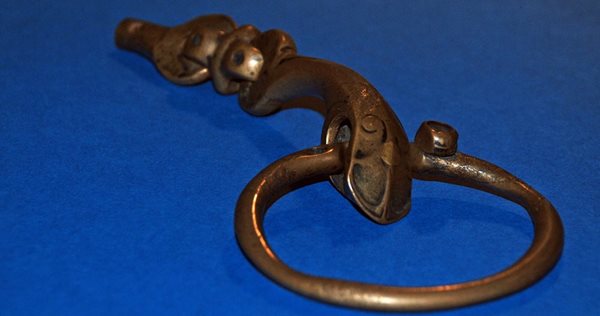Early Iron Age
La Tène Horse-Bit
From Streamstown, Co. Westmeath
By Leo McNameeDescription
This object formed part of a harness used to control horses in Early Iron Age Ireland and dates to around the second century AD. Decorative horse-trappings like these, often inlaid with glass enamel, are evidence of the high esteem given to horses and horse-drawn vehicles at this time and would have enhanced the social status of the owner. Horses were expensive to keep and would only have been used by the social elite.
The surviving portion of the bit is of cast bronze and comprises one complete and one fragmentary side-link joined by a central link. One bridle ring is in place and the other is missing. The side-links are hollow cast and oval in cross section. The central link is roughly in the shape of a figure-of-eight and is decorated with four settings that are now empty. The bits show considerable wear and have been repaired with irregular patches of molten bronze. The fragmentary side-link is unusual in that it is has a circular perforation with the remains of an iron rivet inside; it was most likely broken in antiquity and this is the result of repair work.
La Tène Decoration
The most interesting feature of this bit is the decoration, which is in the form of fine cast lines in relief. The terminal of the cast bronze bridle bit is in the form of an animal head with prominent spiral eyes, snout and gaping jaws. The animal head grasps a solid ring which is plain except for an attached stud and single perforation (possibly where a second stud was attached). It is likely that these studs were further decorated with glass inlay. The curvilinear decoration on this object is typical of early Celtic art. This non-naturalistic art style developed across Europe in the Iron Age and is often called La Tène, after the site of a significant votive deposit on Lake Neuchâtel in Switzerland. Celtic art was very different from the Classical realism found in the contemporary Roman world; it was more ambiguous and harder to read. Representations of mythical beasts and human-like faces blurred the boundaries between myth and reality. Stylized animals and birds, such as the one seen here, would engage the viewer’s curiosity and may have linked to ritual beliefs. Weapons, horse-trappings, and decorative objects such as mounts are the most common artefacts found in Ireland that are decorated in this style.

The Horse in Iron Age Ireland
Over 130 bronze horse-bits dating from the Iron Age have been found throughout Ireland which implies that travel on horseback was widespread at this time. These are mostly isolated finds but matching pairs have also been found. The chariot is well represented in European archaeology and is mentioned in relation to Britain by Roman sources such as Julius Caesar; chariots are also depicted on Celtic coins. However, there is little archaeological evidence for the chariot in Iron Age Ireland and it is more likely that pairs of horses were used to pull simple carts instead.
The Corlea trackway in Co. Longford is an example of an impressive Iron Age road which further demonstrates that travel by horse/horse and cart was common. It was built to cross the bog using large oak planks and is dated to 148 BC. Fragments of wheeled vehicles, horse-bits and leading pieces have also been found deposited in bogs as votive offerings. It has been suggested that these might have been connected to the inauguration ritual of a new king. It is also possible that objects associated with ploughing might have formed part of fertility rituals.
Learn more…
This horse-bit was acquired by the museum in 1948 from Canon P Power of John’s Hill, Co. Waterford for a fee of £180. It is not currently on display and is part of the museum’s reserve collection. However, a similar pair of bronze horse-bits from Attymon, Co. Galway is on display in the Kingship and Sacrifice exhibition in the National Museum of Ireland – Archaeology.
Bibliography:
Farley, J. (2015) “Celts: Art and Identity”, The British Museum Press
Raftery, B. (1983) “A Catalogue of Irish Iron Age Antiquities”, Marburg
Raftery, B. (1991) “The Early Iron Age”. In: Ryan, M. ed. The Illustrated Archaeology of Ireland, Country House
Raftery, B. (2005) “Iron-Age Ireland”. In: Ó’Cróinín, D. ed. A New History of Ireland: Prehistoric and Early Ireland, Oxford University Press
Location:
La Tène Horse-Bit is located at:
In Storage
Previous artefact:
Jane Stephens, 1879-1959: Naturalist and Museum Worker
Next artefact:
Late Neolithic Flint Daggers from Denmark
